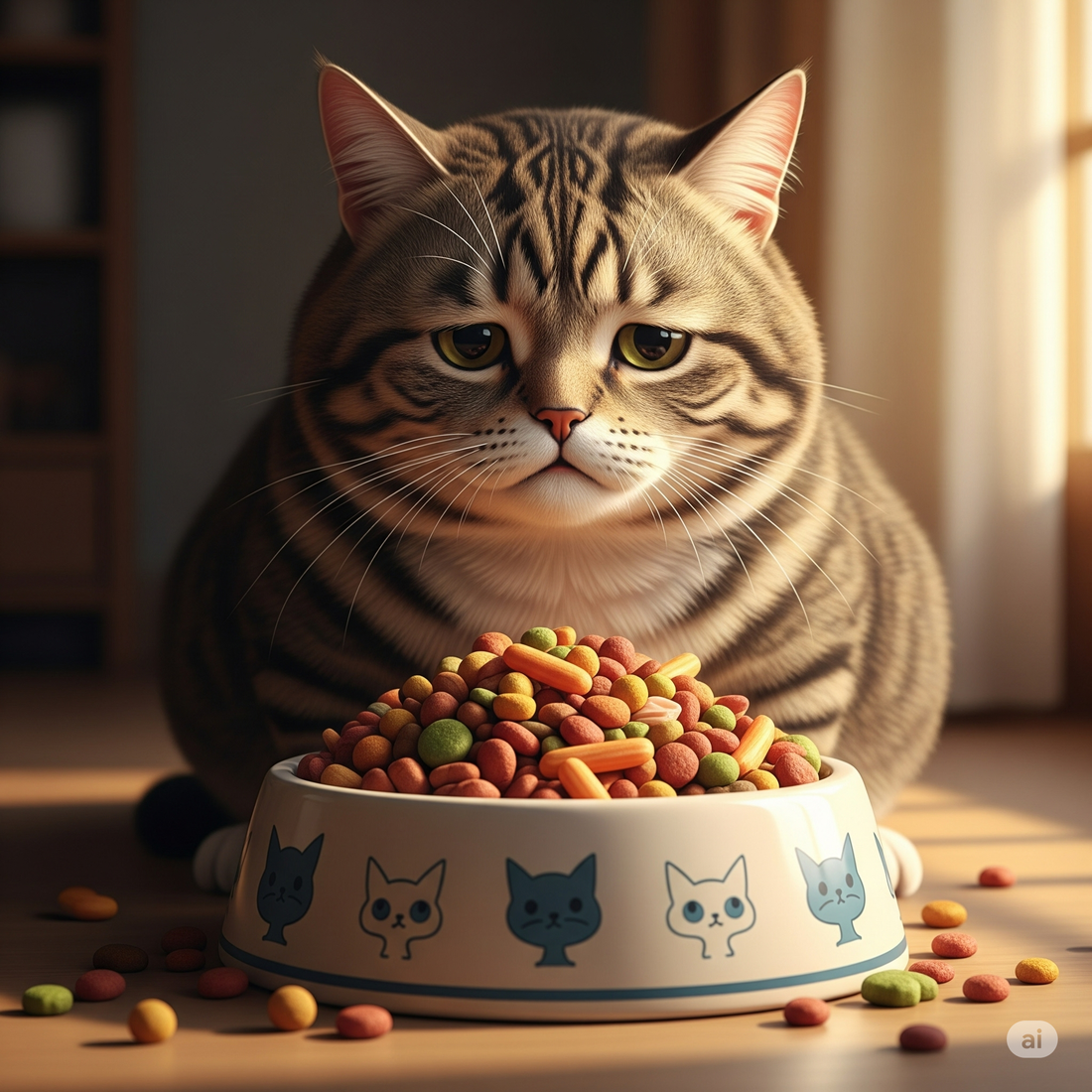
The Hidden Dangers of Overfeeding Your Cat: What Every Loving Owner Needs to Understand
Share
There's something deeply satisfying about watching your cat eagerly approach their food bowl, their whole body vibrating with anticipation as they prepare to enjoy a meal. That contented crunching sound, the way their tail curls happily as they eat - it's no wonder we're tempted to give them just a little extra, just one more treat, just another scoop to see that pleasure again. But beneath this well-intentioned generosity lies a quiet danger that's silently affecting millions of domestic cats worldwide. The act of overfeeding, often done out of pure love and affection, has become one of the most significant yet overlooked health threats facing our feline companions today.

Is Your Overfeeding Slowly Harming Your Cat? The Silent Dangers You Need to Know
The relationship between cats and food is fundamentally different from our own. In the wild, cats are obligate carnivores designed to consume multiple small meals throughout the day, feasting primarily on protein-rich prey. Their bodies are finely tuned machines evolved for feast-and-famine cycles, not for the constant availability of calorie-dense foods that modern domestic life provides. This mismatch between their evolutionary design and our modern feeding habits has created what veterinarians are now calling a feline obesity epidemic. Recent studies suggest that nearly 60% of cats in developed nations are overweight, with a significant portion classified as clinically obese. What's more concerning is that many owners of these overweight cats don't recognize there's a problem at all, having gradually adjusted to their pet's increasing size over months or years.

Understanding why overfeeding is so dangerous requires looking at how excess weight affects a cat's body. Unlike humans who carry weight in various areas, cats tend to accumulate fat internally around their organs as well as visibly under their skin. This internal fat is metabolically active, secreting hormones and inflammatory substances that disrupt normal bodily functions. One of the first systems affected is the endocrine system, where fat cells interfere with insulin regulation, dramatically increasing the risk of diabetes mellitus. Feline diabetes is not just a manageable condition like in humans - it requires intensive treatment including twice-daily insulin injections, strict dietary control, and frequent veterinary monitoring, all of which significantly impact both the cat's quality of life and the owner's lifestyle.
The skeletal system bears another heavy burden from excess weight. A cat's lightweight, flexible frame was designed for agility and explosive movement, not for carrying extra pounds. Each additional ounce of body weight puts disproportionate stress on joints, particularly the hips and spine. Over time, this leads to degenerative joint disease, arthritis, and chronic pain that owners often mistake for normal aging. You might notice your cat hesitating before jumping onto furniture they once accessed easily, or perhaps they've stopped grooming certain hard-to-reach areas because the movement has become uncomfortable. These subtle changes are often the first visible signs of weight-related joint stress that will only worsen without intervention.
Perhaps most alarming is the effect of obesity on a cat's liver. Felines have a unique metabolism that makes them particularly susceptible to a condition called hepatic lipidosis, or fatty liver disease. When an overweight cat stops eating for any reason - whether due to illness, stress, or even just being finicky - their body begins rapidly breaking down fat stores to use as energy. Unlike other animals, cats' livers aren't efficient at processing this sudden flood of fat, leading to a dangerous accumulation that can cause liver failure. This condition develops frighteningly quickly and is often fatal without aggressive veterinary treatment, making prevention through weight management absolutely critical.
The respiratory and cardiovascular systems also suffer under the strain of excess weight. Fat deposits around the chest cavity restrict lung expansion, while the heart must work harder to pump blood through additional body mass. Over time, this leads to decreased stamina, increased respiratory effort (often visible as heavier breathing after minor exertion), and ultimately can contribute to heart disease. Many owners misinterpret their overweight cat's lethargy as contentment or laziness when in reality, their body is struggling with the physiological equivalent of constantly carrying a heavy backpack.
What makes feline obesity particularly insidious is how gradually it develops and how easily it's overlooked. Cats are masters at hiding discomfort, and weight gain happens so incrementally that owners often don't notice until their cat is already significantly overweight. The shift from a healthy weight to obese might involve as little as an extra 20 calories per day - roughly five extra pieces of kibble - accumulating over months into pounds of excess weight. By the time visible changes are apparent, the metabolic damage is already well underway.

Compounding the problem is how commercial pet foods are marketed and how feeding guidelines are presented. Many dry food packages recommend portion sizes that far exceed what an average indoor cat actually needs, and the ubiquitous "free feeding" approach where food is available at all times directly contradicts cats' natural feeding patterns. Even the shape and size of food bowls can contribute to overfeeding, with wide, shallow bowls encouraging faster eating and making portions appear smaller than they are. The pet food industry's emphasis on "complete and balanced" nutrition has ironically led many owners to believe that as long as they're feeding a quality food, the quantity doesn't matter - a dangerous misconception.
Treats represent another hidden source of excess calories. That small piece of cheese, the occasional lick of ice cream, the handful of kibble given as "just because" snacks - these extras can add up to a significant calorie surplus over time. Many commercial cat treats are essentially junk food, loaded with empty calories that provide no nutritional benefit. Worse still, the act of giving treats often becomes an emotional exchange for owners, a way to demonstrate love and strengthen bonds, making it psychologically difficult to reduce or eliminate them even when we know they're not in our cat's best interest.
Recognizing overweight and obesity in cats requires understanding what a healthy feline body should look like. Unlike dogs where breed standards provide clear guidelines, cats have relatively uniform body composition ideals. A healthy cat should have a visible waist when viewed from above, with an obvious indentation between the ribcage and hips. The ribs should be easily felt under a thin layer of fat (but not visible), and there should be minimal abdominal fat pad. From the side, the belly should tuck upward rather than hanging down. Many owners are surprised to learn that what they considered "normal" is actually overweight because we've become so accustomed to seeing heavy cats that our perception of healthy has become distorted.
Addressing feline obesity requires a multi-faceted approach that goes beyond simple dieting. Crash diets are dangerous for cats and can actually trigger hepatic lipidosis, so weight loss must be gradual and carefully managed. The first step is consulting with a veterinarian to determine your cat's ideal weight and develop a safe weight loss plan. This typically involves calculating daily calorie requirements based on the target weight rather than current weight, then selecting an appropriate food and carefully measuring portions. Many veterinarians now recommend ditching the traditional dry food in favor of high-protein, low-carbohydrate wet foods that better mimic cats' natural dietary needs and provide greater satiety with fewer calories.
Feeding strategies are just as important as food selection. Scheduled meal feeding, where specific amounts are offered at set times each day, helps regulate metabolism and prevents constant grazing. Puzzle feeders and food-dispensing toys can slow down fast eaters while providing mental stimulation. Measuring cups should be used religiously - "eyeballing" portions almost always leads to overestimation. Even the feeding environment matters; placing food bowls away from high-traffic areas reduces stress eating, while elevated bowls can improve digestion and comfort.

Exercise is the often-overlooked companion to dietary changes. Indoor cats especially need encouragement to move, as their environment typically provides far less spontaneous activity than their wild ancestors experienced. Interactive play sessions using wand toys that mimic prey movements are ideal for getting cats moving in ways that feel natural to them. Even simple changes like placing food bowls upstairs or using vertical space with cat trees can increase daily activity. The key is making movement fun and rewarding rather than stressful - forced exercise can backfire by creating negative associations.
Perhaps the most challenging aspect of feline weight management is changing owner behavior. We project our own relationships with food onto our pets, assuming they eat for pleasure the way we do when in reality, most cats would be perfectly content with measured, nutritious meals at appropriate intervals. Breaking the habit of using food as love language requires finding alternative ways to bond - through grooming, play, or simply quiet companionship. It means learning to interpret our cats' signals more accurately, recognizing when they're seeking attention rather than food, and resisting those pleading eyes not out of cruelty but out of deeper compassion for their long-term wellbeing.
The rewards of maintaining a healthy weight are profound and far-reaching. Cats at ideal weight are more active, more playful, and generally more engaged with their environment. They groom themselves more effectively, reducing hairballs and skin problems. Their risk of developing serious conditions like diabetes, arthritis, and heart disease plummets. Perhaps most importantly, they're likely to live significantly longer - studies suggest that obese cats may have lifespans two to three years shorter than their lean counterparts. When viewed through this lens, resisting those extra treats becomes not an act of deprivation but one of profound love and commitment to sharing as many healthy years together as possible.
In our desire to make our cats happy in the moment, we must remember that true caregiving sometimes requires making choices that prioritize long-term health over immediate gratification. The occasional treat given mindfully and in moderation isn't harmful, but consistently overfeeding - no matter how well-intentioned - is one of the most significant threats to our cats' health and longevity. By understanding the very real dangers of excess weight, learning to recognize healthy body condition, and implementing measured feeding practices, we give our feline companions the gift of vitality and the promise of more years by our sides. After all, the greatest expression of our love isn't found in an overflowing food bowl, but in the quality and quantity of life we help them achieve.
